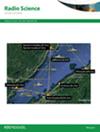比较离散和经验对流层延迟模型:基于全球 IGS 的评估
IF 1.6
4区 地球科学
Q3 ASTRONOMY & ASTROPHYSICS
引用次数: 0
摘要
天顶对流层延迟(ZTD)是全球导航卫星系统(GNSS)等无线电-空间-大地测量技术中的一个重要大气参数,对 GNSS 定位、导航和气象学至关重要。维也纳测绘功能(VMF)数据服务器是实现 ZTD 的一个广泛使用的数据源,提供两种类型的模型,即经验模型和离散模型(包括网格模型和站点模型)。因此,评估这些模型的准确性成为本文的重点。具体而言,本研究以从国际全球导航卫星系统服务数据中得出的每小时数值为参考,研究了它们在计算 ZTD 方面的性能。结果表明,按站点、按网格和按全球气压和气温 3 个模型计算的均方根误差(RMSE)分别为 11.71/13.03/38.56 毫米,表明离散模型的性能总体上优于经验模型,而按站点模型是两个离散模型中性能较好的。从空间分辨率来看,三种模式在 ZTD 计算中的表现受纬度变化和高差的影响明显。从时间分析来看,离散模式的精度在不同UTC时区表现出差异,而经验模式只能表达季节性的ZTD特征,不同时区的平均有效值相近,具体数值分别为UTC 0:00、6:00、12:00和18:00时的39.67、39.26、39.38和39.18毫米。直方图和方框图很好地显示了三种模式在不同季节的精度差异。此外,本研究还探讨了三种模式在不同纬度的时间序列。这些探索有利于根据具体要求选择合适的模型来计算 ZTD。本文章由计算机程序翻译,如有差异,请以英文原文为准。
Comparing discrete and empirical troposphere delay models: A global IGS-based evaluation
Zenith tropospheric delay (ZTD) is an important atmospheric parameter in radio-space-geodetic techniques such as Global Navigation Satellite System (GNSS), which is pivotal for GNSS positioning, navigation and meteorology. The Vienna Mapping Function (VMF) data server is a widely utilized source for implementing ZTD, offering two types of models, that is, the empirical one and the discrete one with Grid-wise and Site-wise models. Therefore, to evaluate the accuracy of these models becomes the focus of this article. Specifically, this study investigates their performances in terms of calculation of ZTD, using the hourly values derived from the International GNSS Service data as references. The results show that the root mean square err (RMSE) of the Site-wise, Grid-wise and global pressure and temperature 3 model are 11.71/13.03/38.56 mm, respectively, indicating the discrete model performs generally better than the empirical model, and the Site-wise model is the better of the two discrete models. From the perspective of spatial resolution, the performance of these three models in ZTD calculation shows obvious influences of latitude changes and elevation differences. From the temporal analysis, the accuracy of the discrete model shows differences over different UTC epochs, while the empirical model can only express the seasonal ZTD characteristics with the average RMSE at different epochs being similar, the specifically values are 39.67, 39.26, 39.38 and 39.18 mm at UTC 0:00, 6:00, 12:00 and 18:00, respectively. The histogram and boxplot well indicate the accuracy differences of the three models in different seasons. Additionally, the time series of three models at different latitudes were also explored in this research. These explorations are conducive to the selection of appropriate models for calculating ZTD based on specific requirements.
求助全文
通过发布文献求助,成功后即可免费获取论文全文。
去求助
来源期刊

Radio Science
工程技术-地球化学与地球物理
CiteScore
3.30
自引率
12.50%
发文量
112
审稿时长
1 months
期刊介绍:
Radio Science (RDS) publishes original scientific contributions on radio-frequency electromagnetic-propagation and its applications. Contributions covering measurement, modelling, prediction and forecasting techniques pertinent to fields and waves - including antennas, signals and systems, the terrestrial and space environment and radio propagation problems in radio astronomy - are welcome. Contributions may address propagation through, interaction with, and remote sensing of structures, geophysical media, plasmas, and materials, as well as the application of radio frequency electromagnetic techniques to remote sensing of the Earth and other bodies in the solar system.
 求助内容:
求助内容: 应助结果提醒方式:
应助结果提醒方式:


